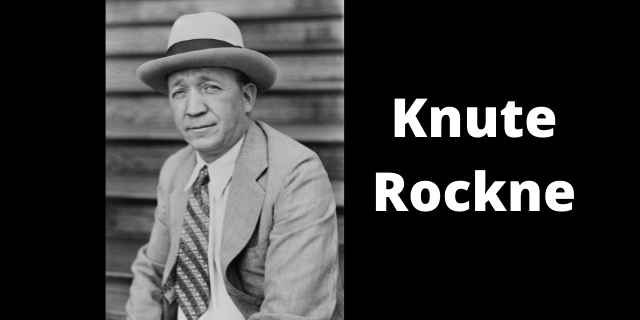The Los Angeles Rams are touted as masters of the play action. It’s one of the factors that got them to the 2022 Super Bowl.
But the Rams didn’t invent the play action pass. Early versions have been in the game since the 1900s. But who was the original inventor?
If you’re not familiar with the move, you can check out our article that fully explains the play-action pass.
Who Invented The Play-Action Pass?
The invention of the play-action has been credited to various people, including John Heisman, Knute Rockne, and George Halas.
The answer comes down to what you consider a true play-action.
In our opinion, John Heisman was the first coach to run a passing play disguised by a faked handoff. However, this was too different to what we know as as the modern play-action to be considered the first appearance of the play.
The modern play fake was first developed by George Halas, who established the Chicago Bears in the 1920s.
Halas was coach in 1940 when the Bears used a tactic that they called the “play-fake”. This was very close to the modern play-action.
This play was later perfected by Hank Stram and Bill Walsh to become the play-action pass we see today.
Let’s take an in-depth look at these great innovators.
John Heisman’s Fake Plays
John Heisman is considered the father of the forward pass. He lobbied Walter Camp for years to allow the forward pass to be legal and finally prevailed in 1906.
You can read more about this major change in the sport in our article on how the forward pass came into football.
Heisman was famous for his love of deception.
This included a quickly banned play where the runner stuffed the ball down his jersey, then ran down the field with his hands empty so everyone would ignore him!
Heisman’s fake plays
Heisman certainly ran pass plays that looked like runs.
In 1907, Heisman was coaching at Georgia Tech.

He introduced what was known as the “jump shift”. Heisman got his players to shift position before the ball was passed back to the quarterback.
This led the other team to charge too soon and take a penalty for being offside.
L.F. Woodruff wrote a history of southern football in 1928. He refers to an admiring spectator describing the play like this:
“That’s a neat trick of Heisman’s in making a fake move just before the ball was snapped.”
Heisman himself had a longer description in one of his many articles on football.
The team, after seemingly assuming a settled position or formation, rapidly shifts one or more of its men to new positions and then shoots the ball into play immediately after those men have come to a stop in their shifting movement.
Heisman
However, this fake move doesn’t end with the ball being passed. But we can see how it could easily evolve into the full play-action-pass.
At the time of his death, Heisman had just started writing a history of football. If only he had finished it, we would almost certainly know more!
Knute Rockne’s Disguise Plays
Other coaches developed and refined offensive shifts in the early decades of the 20th century.

Knute Rockne was one of the major innovators in the passing game during his time at Notre Dame University, both as a player and coach.
Rockne was a former chemistry professor who had plenty of charisma. Whereas Heisman had a gruff manner with his players, Rockne took a more personal approach.
He wrote in the 1930s about his belief that the best way to run a pass play was to disguise it as a run. His favorite way to do this was to fake an off-tackle run.
While Rockne wrote about this in the 1930s, his career at Notre Dame began in 1913.
So we don’t know when he actually started running these types of fake plays.
George Halas And the Play-Fake
After George Halas established the Chicago Bears in the 1920s, he both coached and played on the team.

Halas famously stripped the legendary Jim Thorpe in a 1923 game and returned it for 98 yards. This remained the league record until 1972!
He finally hung up his boots in 1930 but was coaching the Bears in the 1940 season.
Most people got their first exposure to something that looked like a modern play-action pass in the 1940 NFL Championship game between the Bears and the Washington Redskins.
Halas’s team was running their innovative T-Formation offense.
This is the forerunner of all modern offensive formations. Before this, teams ran offensive formations known as either single wing or double wing.
The play-fake
In the T, with the quarterback under center, the Bears ran a fake handoff run/pass to defeat the Redskins 73-10!
The Bears called this play a “play-fake” and this was its name until the 1960s.
This game is most likely the first use of what we would recognize as the modern play-action.
While Heisman and Rockne both ran fake handoff passes, the base formations and blocking schemes would look very different from modern football.
This is why we consider George Halas to be the inventor of the play-action pass.
Hank Stram And The Rollout
Hank Stram was the coach of the Kansas City Chiefs in the 1960s. He had a very accurate quarterback named Len Dawson.
However, Dawson was relatively short for a football player. His height of six feet gave him difficulty in seeing over the linemen.
Stram instructed his quarterback to fake a handoff, then run to his right. This allowed him to see the field and where his receivers were.
You’ll be very familiar with this rollout. Quarterbacks still do it today as part of the play-action pass.
Bill Walsh And The Modern Play-Action Pass
The play-action passing we see in the NFL today comes directly from the “West Coast Offense” pioneered by Bill Walsh with the San Francisco 49ers in the 1980s.

The West Coast Offense is a passing-based offense that is focused on short passes with the quarterback getting the ball out of his hands quickly.
The techniques for selling the fake and schemes for blocking the play all come from Walsh and his assistants who went on to coach other teams.
The Los Angeles Rams reached the 2022 Super Bowl as the most noted current users of play-action passing in the league.
The Rams coach, Kyle Shanahan, is a direct descendant of the Bill Walsh coaching tree!